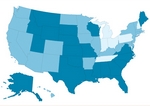government
California counties get 2nd chance to challenge Medicare payments
■ Physicians say a proposed class-action lawsuit highlights the perils of an antiquated formula that underpays them by 10% to 25% in urban areas.
By Amy Lynn Sorrel — Posted Oct. 18, 2010
- WITH THIS STORY:
- » External links
- » Related content
A recent court decision gave a group of California counties another chance to challenge what they contend are severe Medicare underpayments that jeopardize access to care across the country.
The proposed class-action lawsuit led by seven California counties alleges that Medicare is underpaying California physicians by 10% to 25% in urbanizing areas because the Dept. of Health & Human Services has failed for more than a decade to adjust appropriately for certain geographical differences in the cost of providing care. Doctors in some Texas, North Carolina and Minnesota counties also are among those most affected.
A federal trial court dismissed the case in 2009, saying the California counties did not have standing to sue on behalf of doctors.
But a Sept. 29 decision by a 9th U.S. Circuit Court of Appeals panel gave the case new life. Despite again dismissing some portions of the case, judges said the California counties could pursue their claims that the government's lack of action may violate their equal protection rights.
Lead attorney Dario de Ghetaldi said the problem stems from a Medicare payment formula that still groups some urbanizing areas with rural areas under a locality map used to determine the geographic practice cost index. Because local costs are averaged to determine payments, the structure does not account for increasing work expenses in the growing regions.
"The pinch is being felt by doctors in over 200 counties nationwide that treat Medicare patients," de Ghetaldi said.
The last time Medicare updated the localities was in 1996, based on even older data, he said. The California counties allege that doctors there are collectively owed $340 million in back pay from 2001 to 2007. Texas doctors came in second at $246 million, followed by physicians in North Carolina at $177 million and Minnesota at $165 million.
The counties' lawsuit also asks that Medicare reclassify the urbanizing counties into separate localities that accurately reflect their costs.
The Centers for Medicare & Medicaid Services did not respond to requests for comment. It remains unclear whether the federal government will appeal the ruling to the full 9th Circuit.
Federal officials, while aware of the disparities, argued in court documents that, because a solution must be budget neutral, they have yet to find a remedy that would not result in reduced payments to some doctors, likely in rural areas.
Physicians say the lawsuit highlights the perils of an antiquated Medicare pay formula.
For example, in San Diego County, one of the plaintiffs, payments are the lowest in the state, despite having one of the highest living costs, said Ted Mazer, MD. A San Diego otolaryngologist, Dr. Mazer is a past president of the San Diego County Medical Society, which supports the lawsuit.
"We already have problems attracting doctors. And now, with more threatened [Medicare] cuts, we simply have more doctors saying we are not taking new Medicare patients, or Medicare patients altogether," Dr. Mazer said.
A shortage of doctors in California's Santa Cruz County, where physicians get paid 25% less than their urban counterparts next door in San Mateo County, has forced many patients to head to emergency departments or drive farther for treatment, de Ghetaldi said.
But physicians want to ensure that any approaches to changing the payment formula do not unfairly penalize doctors in rural areas or those who are not underpaid, said family physician Larry de Ghetaldi, MD, chair of the California Medical Assn.'s Medicare reform committee. Dr. de Ghetaldi, brother of the lead attorney in the case, is not involved in the lawsuit. The CMA has no position on the case.
"We recognize that there are rural access problems" across the country, he said. "And we recognize we are dealing with a budget-neutral problem here. But essentially what we want to promote is payment accuracy."
The CMA, as well as the American Medical Association, testified in September before an Institute of Medicine committee asked by the federal health care law to study the issue. The associations advocate for the use of current, reliable and transparent cost data in determining geographic payment areas for use in the Medicare physician payment system. The CMA also has proposed freezing any proposed payment reductions that could result from redistributions under the fee schedule geographies until the formula is updated.
"It's good public policy in light of the fact CMS has allowed this to get so broken and go on for so long," Dr. de Ghetaldi said.












